New paragraph
Info old site
13-06-2011
The first round is over and I don't think I can complain, but the red heads are letting me down a bit.
I thought I had put a few nice, selected couples together, but from 1 couple I had a litter of four beautiful, large youngsters. On the advice of a fellow breeder, I put some more thought into which color mutations are best to put together, but I am curious to see what the four youngsters look like when they have gone through the juvenile molt. The parent pair is a 90% yellow wild color male with a 100% winter color female. As it looks now, there are two sea green furs, all four have a light beak color. Know it, know it, say it!!!
The Blue Greens are doing well, there are currently about 10 rinded youngsters in stock, a good result. There is one female in the flight that is not in good condition, but let's wait and see what that will be.
The Maskers are doing well, 1 couple is excellent, is now in its second round and will soon have raised 10 youngsters, a nice couple, on the one hand it's a pity that I'm stopping with the Maskers.
Cuban finches, as usual, are now busy with their second litter and the number of unringed young is steadily increasing. I will also stop this species after the breeding season and will then only focus on papaya finches.
All youngsters were caught when they were independent and placed in the spacious breeding cages, everything neatly according to species :)
I bought a very nice pair of bobtails on Saturday, the male is not yet in color but it is going to be a killer, I will see if I can breed youngsters from them next season. Now still looking for a second couple.
24-04-2011
It's been a year since I updated the site, so I'll try to update it regularly :)
The past year has been a busy year where a number of things have happened privately and professionally, resulting in no time to maintain my site. A lot also happened in terms of birds and I came to the conclusion that given the space I had a lot of birds.
I have made choices and sold many birds, I no longer have any astrildes, belted grass finches, diamond finches, brown-breasted reed finches. And this season I'm going to focus on fewer varieties.
I now have blue-green (forbes) parrot finches, red-headed parrot finches, masked finches and cubu finches. And find out that there are still too many birds. So at the end of the season my breeding pairs of Cuban finches (3x) and masked finches (3x) also leave. And then I want to focus entirely on parrot finches. The blue-green ones are very beautiful, and I also have various color varieties of the red-headed parrot finches, wild color, sea green and the colorful variants of both.
I want to start with bobtails, but then birds that come from the outdoor aviary and are naturally brooded, so if you know a good address, I would be happy to help.
Then the new breeding season started early, unlike in other years. This year we decided to pair the couples early, the result is that they become broody much earlier and are therefore ready sooner.
In the ivy a nest with masks and already flown out on 01-04-2011 and I think that is quite early for outdoors, also ringed with 2010 rings, fortunately I now have the 2011 rings.
In addition, several nests with cubacinks, blue-greens and redcaps, so a great start to the season
I also took some nice pictures again, see you next time!!
05-04-2010
It's been a while since I updated the site, but there is relatively little to report during the winter months. The birds are then in the rest period, are separated and regain their strength for the coming breeding season. During the rest period I always try to let them regain their strength after a breeding season by paying extra attention to their food. The young birds also have difficulty getting through the moult completely. But afterwards she succeeded very well.
The winter period is also the period that I sell the farmed birds simply because I do not have the space to keep them all. In recent years I have learned to keep three flocks of each species and to replace 1 of the three flocks with a young flock, so that I am always guaranteed a healthy turnover.
Two weeks ago the pupae were caught and placed in the breeding cages and the males were added last weekend, so I give the pupae a week to get used to the new environment. I have a total of 12 breeding cages, all of which are now occupied, with brown-breasted reed finches, black-brown Japanese gulls, Ceres amadines and Binsen astrildes.
In the flights I have 1 flight practically empty, the other two flights are mainly populated by 6 pairs of red-headed parrot finches and 1 pair of small Cuban finches.
Today we also provided the flights with nest blocks and you immediately notice that they are getting very excited and the first arguments have already been settled, so it will be an exciting time to see how the first round will go.
I will keep you regularly informed from now on.
8-11-2009
Last week we participated in our mutual exhibition of Color and Song in Alkmaar. I was not planning to participate due to lack of time, but because the association has existed for 60 years, I still submitted two birds. The birds have been caged for a very short time and I consciously opted for a somewhat calmer bird and that became the brown-breasted reed finch. Two beautiful birds that actually needed a few weeks to be completely ready, but there was no time.
Ultimately not dissatisfied with the result, namely a 1st prize. I think. a beautiful doll with 91 points.
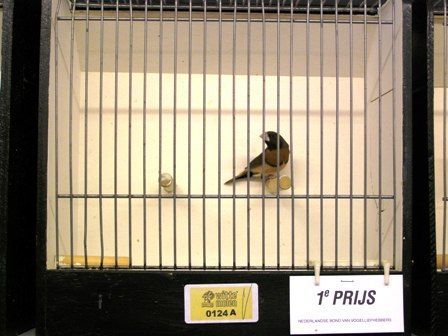
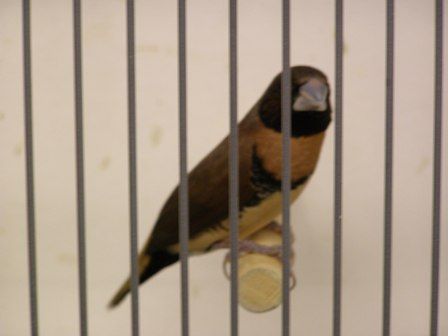
We also submitted a few birds for the sales class, but unfortunately only a pair of red-headed parrot finches were sold. If you are interested in my birds, please take a look at supply and demand.
18-09-2009
I thought the season was coming to an end, almost all the nest boxes had been removed, but the birds think differently. The red heads in particular remain active, so much so that a litter of young red heads has been thrown out of the nest to steal the nest box. Unfortunately, the four young did not survive.
The following birds are still breeding: ceresses, finches, Cuban finches and Japanese gulls.
Cleaned the bread cages last week and caged the young birds, tomorrow clean the flights and then rearrange them.
From now on, the first birds are for sale, see supply and demand. Beautiful, healthy birds ringed EC 2009 from the outdoor aviary. If you are interested, please let me know.
29-08-2009
The final round has begun and is almost at its end. This week the four masks finally flew out, very clumsy but oh so nice to see. (photos see mask finches).
Furthermore, a pair of brown breasts with young, they can do it themselves, I hope it works, unfortunately not the last few times. The Ceressen have a litter of ringed youngsters, a litter of four, of which I expect that the smallest youngster will not survive. Another litter of Red Heads, Japanese Gulls and a litter of Binsen who have made a beautiful nest in the ivy themselves.
Based on my Germany purchases, I have been searching the internet to see if I can buy hirse somewhere and I have succeeded. This company produces all kinds of home-grown millet of excellent quality. http://www.kolbenhirse.de/ . Ordered last week and arrived neatly packaged and of top quality within two days. And the birds love it, highly recommended.
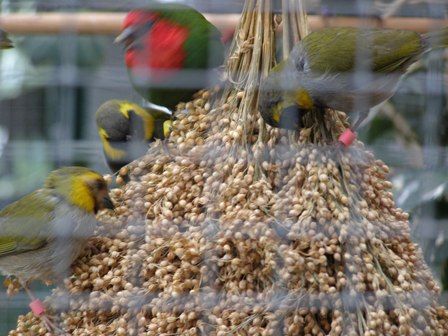
15-08-2009
Today in Germany we picked up a number of pairs of colorful redcaps, absolutely fantastic, beautiful birds from a reliable breeder who is going to stop his hobby. Quite a long journey, but the results are impressive. Two beautiful couples and 1 of the couples has 2 young.
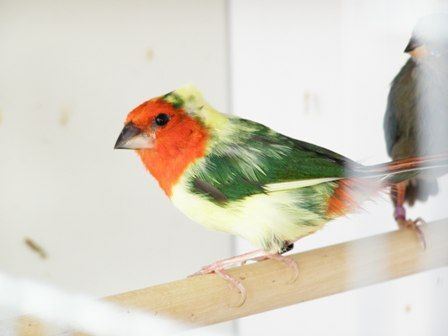
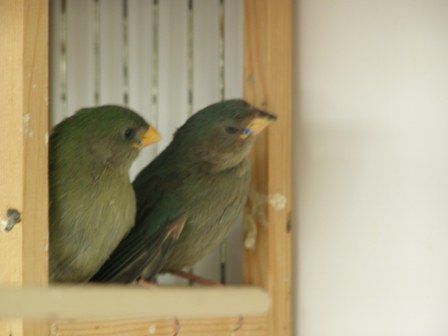
Let's see how I will link it in the new season and see how my own red heads fit into the picture. I actually want to focus on breeding colorful red-headed parrot finches. The other photos are of the red-headed parrot finches.
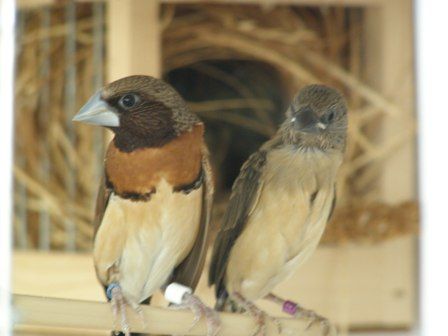
In addition, the young of the brown-breasted reed finches have fledged. A beautiful couple that laid eggs neatly, but after three days the young were no longer fed and now no problem raising the three young. Below is a photo of a parent with young.
The naturally hatched maker finches are also doing well. Today I ringed the fourth of the nest. I had already ringed the other three youngsters this week, but this youngster was a bit smaller.
02-08-2009
It's been quiet on my site for a while now, because due to sad family circumstances it hasn't happened in recent months. Today I'm going to try to pick up the thread again with a short review of recent times.
As you may know, I have three flights, and one of those flights contains my young birds. When I look at this, I am again very satisfied with the past season. There are many young birds flying around and I have already stopped with a number of couples and a number of couples have just started or are in their second round.
Below is a small impression of young fruit-eating birds, a beautiful sight, isn't it?
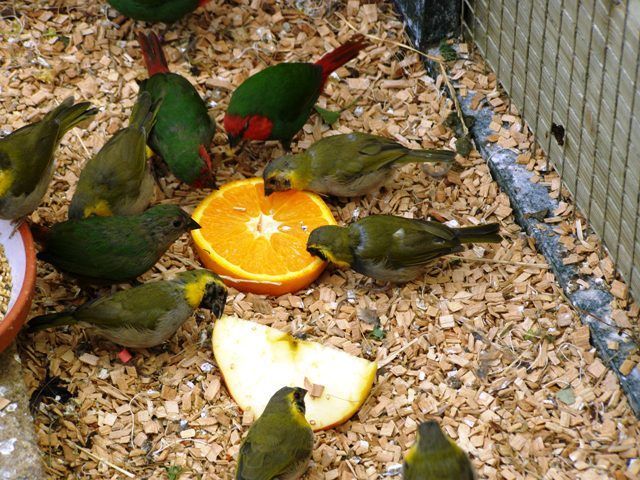
In the first flight where the young are located, it is very busy, there are young Cuban finches, red-headed parrot finches, Japanese gulls, brown-breasted reed finches, brown-breasted finches and ceresses flying around and the juvenile molt is in full swing. Under the topic of brown-breasted reed finches I took a number of moulting photos, which are certainly worth a look.
In the second flight I saw red heads, masks, bichenows and ceresses flying around, usually a couple or 2 or 3. The strange thing is that no young are born here all season. Strange, but maybe it has to do with the possible unrest of flights 1 and 3. Let's see if I can organize this differently next season. Now the masks and ceresses are on eggshells, maybe it will become something.
In the third flight, red heads, finches and cuba finches fly around. Things always go "well" with the red heads and Cuba finches. The birds were first allowed to try it in the breeding cages, where there were young, but after a few days they were not fed. The last brood is now among the seagulls, five of which have hatched and I have to ring them this week. This year I started colony breeding for the first time with the red-headed parrot finches, 3 couples in each flight, only in flight 3 results but no large nests, all litters with a maximum of three young, I am used to that differently.
In the breeding cages I have a pair of brown-breasted reed finches, young birds without experience, they have had several nests but the young were not fed, fortunately the last attempt was successful. A litter of four, well fed and today they were ringed, I just hope they fledge. Also a pair of ceresses with fledged young and busy with the next nest. I continue to find it difficult to determine when to stop. Once they have raised 2 nests it should be enough, I think, but the birds often think differently about it, so as long as the weather is nice they are allowed to stay for a while.
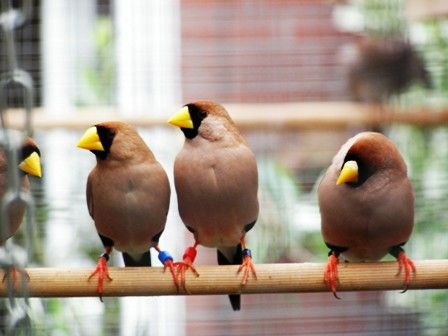
25-05-2009
The young quails have now grown large and ultimately three survived. A nice couple where the yellow youngsters are mottled white.
Today I came home and my pair of Chinese quail have five young ones, they look like Easter chicks in a flower arrangement. Nice, isn't it!
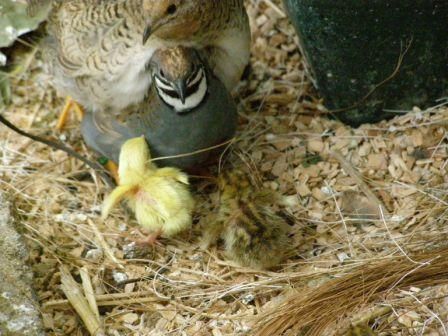
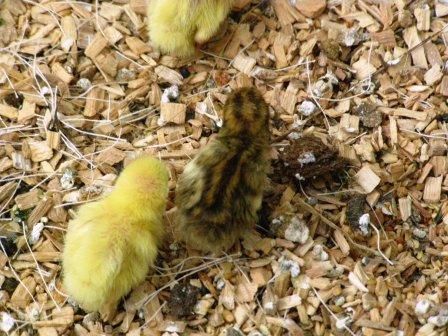
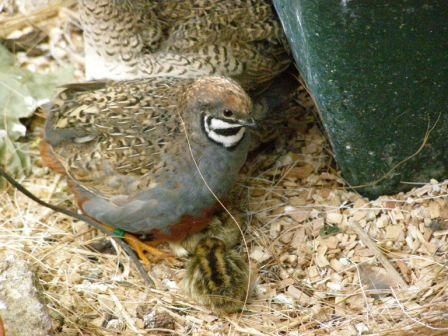
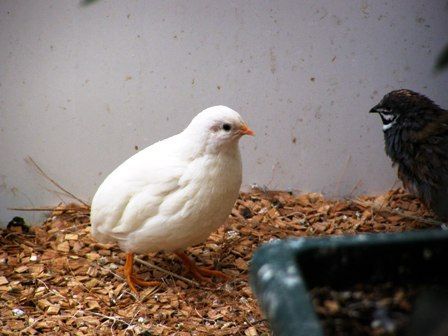
24-05-2009
Yesterday I caught my young Cuban finches from the first couple and put them in a spacious breeding cage, which I had left because I had moved my Bichemows to the two flights. I came this morning and they were happily flying around in my lock, luckily I noticed and they were quickly back in the cage. The cause was that the inset bar that normally houses the nest block had too much space, so it was immediately secured with a tyrip.
I also immediately took some pictures of bathing birds, it remains difficult to take good pictures through the mesh, tips are welcome.
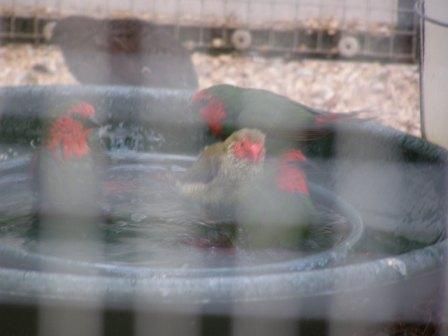
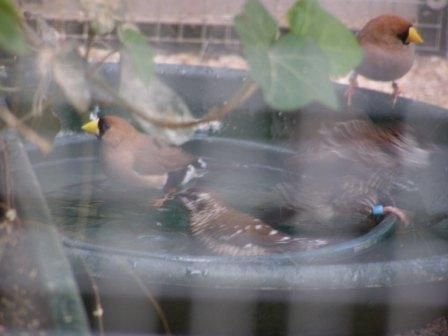
21-05-2009
This morning I provided the young of the red-headed parrot finch with a color ring so that I can easily separate the young.
Also staying with the neighbors' canaries for two weeks, the men have gone to Greece and the 5 canaries are allowed in the big flight, they are having a great time. Only the men are constantly in trouble. Ricky was put aside in a breeding cage, so there are 2 couples left and it is a little quieter. The first couple already has their first egg today.
The two pairs of bichenows were taken out of the breeding cages and both put in a separate flight, one pair did nothing, the other has two nests with unfertilized eggs, so a change in siskin means eating, who knows, maybe it will work out now.
The Cuban finches and red heads have started the second nest again, the eggs are already there. The brown-breasted reed finches have fledged, a beautiful trio.
And the birds have two young ones, I'm curious to see if it will work, they are now about 4 days old, but I have the feeling that things are going to be difficult, they are easily disturbed and leave the nest a lot, just wait a little longer otherwise they will go under the seagulls .
Yesterday, by the way, a brown breast was rescued and placed among the seagulls. It's amazing that the seagulls simply accept and feed a strange youngster while sitting on eggs.
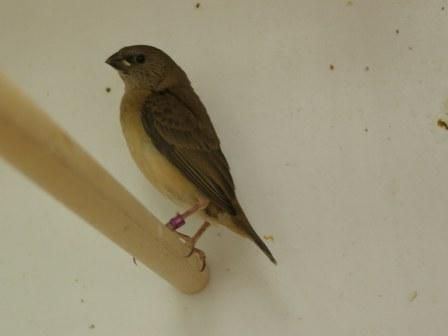
09-05-2009
Today the first red-headed parrot finch flew out. Father a European Championship bird 2008 and a new young female 2008 from Hans from Beekbergen, the couple clicked immediately when I put them together and see below the result of a litter of three.

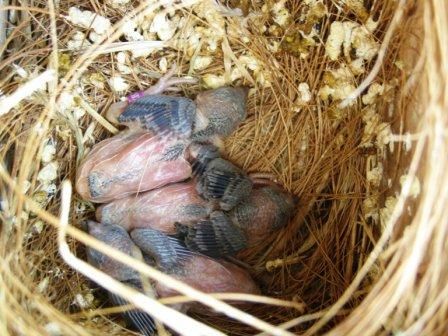
Today I also ringed a litter of brown-breasted reed finches, two young ones were still able to be ringed with 2.7, but I was a day or so late with the third young one and so I ringed it with 2.9. For the first time these birds, but what I find striking is that they grow so slowly, but that could of course also be due to the parents. This week there are a few more fledglings in the pipeline, 2 nests of red heads and a litter of small Cuban finches. What is strange about this is that I always have the feeling that the parents are never on the nest, whether there are eggs or young ones, I never see them and never hear/see them feeding. But they really carefully opened the side of the homemade nest last week.
26-04-2009
Ringed the first boy yesterday. The well-known species, namely the red-headed parrot finches, three beautiful young in one nest and the other nest will be ringed in the middle of next week and this week some eggs will hatch from the other smoke-headed couples. The Cuban finches are growing nicely, but ringing the young of both couples is really not possible.
Other nests had no young, it looked hopeful in terms of nests and eggs, but almost everything was unfertilized. The couples that had young stopped feeding after about 3 days, these two couples are still young so that will work next time. No other results yet, but I will keep you informed. If I find the time I will put some nice pictures on the site again.
19-04-2009
Most couples are sitting on eggs, so that's good.
Last week we also saw the first young ones, several pairs of red-headed parrot finches, Cuban finches and common finches. Next week I expect a number of more species to have young. Experience shows that the first round is usually mediocre in terms of fertilized eggs.
Today I also tried to ring the young Cuban finches, but I stopped doing that. The cubs have made a nest in the ivy, so it is difficult to get to it anyway, we eventually succeeded, but getting the young out is quite a hassle. After squirming for 10 minutes I stopped and put the young one back because I couldn't get hold of the other young one. Then just a beautiful boy without a ring. My other pair of Cuban finches has also made a very nice nest with a long tunnel, so I can't reach it either, which is a shame.
Because of the wonderful weather, I now have three windows open as standard, they love sitting in the sun in the morning, this time not behind glass, but wonderful, just bathed, drying in the morning sun. I don't think you can imagine a better start to the day as a bird, right?
29-03-2009
All nest boxes were hung last week, both in the breeding cages and in the three flights, and nesting material was provided a few days later.
The first nests are already ready and I already have a few couples that have laid their first eggs. So the start is good, the breeding season started earlier than in recent years. The temperature is still variable at night, so I try not to let the temperature drop below 7C. Well, today I clipped the nails of the Belted Grass Finches, hopefully this will benefit fertilization.
20-03-2009
I'm completely ready, I did the big spring cleaning over the past two days and it looks spick and span again. It always improves when everything is clean again. The ivy has been updated again, the branches have been replaced and everything has been nicely soaked. Still a nice aluminum aviary, never have to paint again and relatively easy to keep clean.
Immediately linked all birds in the flight as much as possible into two flights, in order to have 1 flight in which to cage the young. I wonder which couple will have the first boy.
No nest boxes have been hung yet, I will do that on Sunday. Tomorrow we're going to Beekbergen to buy two pupae to complete the red-headed parrot flocks again. Actually, only one is needed, but one unrelated one is never missing as a spare.
Nothing as changeable as a human, I would put all red heads in colony brood, but I decided to give it up anyway. I put my pied male in a separate flight with the female that raised the most young last year, so I try to get some pied to breed young. In another flight I have three couples, so it is a slimmed down form of colony brood.
01-02-2009
Updated the bird administration on Saturday so that I know exactly what I have and all the birds are redistributed over the flights. All men and dolls separated for the next month and a half. And depending on whether the birds become broody, slowly but surely place them in the breeding cages.
I always put the female in the breeding cage first and leave her alone for at least a week so that you can get used to it before the male comes along and then just hope that things click and things start building quickly.
24-01-2009
Received my rings for the new season last night and unfortunately I can't wait to ring the Cuba finches. In retrospect I shouldn't have done it, I probably lost both youngsters because it was just a matter of roosting. Normally I do it in the morning, keep an eye on it during the day to see if it goes well, another lesson learned, too bad.
Posted a few new photos of: Bichenows, Ceressens, Masks and Brown-breasted Reed Finches.
17-01-2009:
All my youngsters from this year were sold last week, now I only have the couples left that I want to breed for the coming season, as well as three flights full of birds. In the spring I can sell a few spare birds and then breeding can start again, I am hopeful.
Over the years I have bought and traded a few more birds and I am completely ready for it.
My breeding cages are now all empty, 1 block is already clean and ready for breeding and the other block still needs to be cleaned this week.
Today I bought a male Cuban finch in Hoorn because one of my breeding males suddenly lay dead on the ground, which is a shame, but unfortunately that is the case.
It's amazing that the other pair of Cuban finches built a nest in the ivy and are now sitting on young ones. The bird world is strange, I want to give the birds some rest before they can go back to work in April, but they don't care about this. I hope I have the rings in time to ring them, that would be great.
27-12-2008
It's cold outside, luckily the radiator is on and I can keep the temperature between 4 and 8 degrees. The birds are doing well in this weather, heating is purely because otherwise it becomes too humid for them and that bothers them.
In recent days I have sold some young birds from this year, I want to sell the last beautiful couples before the end of January and then I can fully focus on the new breeding season.
Still need a few birds, a male Masked Finch, I think I still have two dolls from this year, exchanging would also be an option.
And a male Cuba finch, my own husband, died suddenly last week, cause unknown. I still have a few men of my own, but I would like an unrelated couple.
So if you have something for me, please email me, they have to be cold otherwise I will wait a while.
07-11-2008
Today is an exciting day, or so you would think, but why?
Over the past few weeks I have been busy selecting my young birds, quite a job when you have so many, but in the end I succeeded. The birds have been selected for the exhibition and that will be a job to live up to my own expectations.
I have sent in many birds and when they were caged I discovered that the birds were not ready yet. And that is also the reason why I have not participated in recent years. Things were a bit different then because I still had Goulds at the time and they weren't even in color yet in November.
Now it also applies to most of the birds submitted. When I look at my red-headed parrot finches, they have not yet completely gone through the moult and the same also applies to my diamond finches and this is clearly visible in the number of spots in the flanks.
My ceres finches and my Cuban finches are beautiful, I expect a reasonable result from these and I will find out whether they will be successful tonight at the opening of the exhibition, so I am quite curious.
I have entered my other birds in the sales class. This way there is a nice variety of Australian beautiful finches in the sales classes. I have three pairs of Cuban finches for sale. 5 pairs of red-headed parrot finches, 2 pairs of Ceres finches, 5 diamond finches and 4 pairs of beautiful Japanese gulls.
I will post the results tomorrow on my exhibition page.
21-09-2008
Added photos of young ceresses, brown-breasted reed finches.
Furthermore, the supply and demand page has been adjusted to include the birds that are currently for sale.
29-08-2008
It is urgently necessary to update the site again, but I have not had enough time in recent weeks, I am busy with volleyball again and that takes up a lot of time at the beginning of the new season.
I have been busy with the birds in recent weeks, emptying half of the breeding cages, placing the birds in the flights and cleaning the cages. Immediately removed the dividing walls so that they become nice flights (120) for the young.
Next week we will try to clean the other block, but there are still the last youngsters in it. A litter of Japanese have fledged and will take flight tomorrow. The mask couple still has 3 young and they fledged yesterday, so just be patient.
In the flight I still have a litter of Cuban finches, unfortunately only 1 young, but it is also the third round. In the other flight, the last 2 red-headed parrot finches fledged last week.
So last season I bred a lot of birds and actually of all kinds, now I just select and see what I might want to send to the TT, according to me there are some top birds among them.
Two weeks ago I also sold my last pair of diamond finches, it was a shame they were a nice large pair but they were fairly dominant and disturbed the other couples considerably. The third pair of Cuban finches also sold, in the breeding cages it didn't work out and they weren't really friendly to each other in the flight, but I still have two pairs left, so I'll have to look carefully at how I organize the flights in the new season.
03-08-2008
It's been a few weeks since I updated my blog, but because of the holidays I didn't get around to it. I was back home at the end of this week and picked up the thread again.
First of all, a compliment to Jorgos, my neighbor across the street, who has taken more than excellent care of the birds in recent weeks and has ringed the last nests. Top!!
After returning home, I'm always curious to see how things went and, as I said above, all good, a nest of naturally brooded ceresses was ringed, I think these will fly out at the end of the week.
Also, on the day of my return, four Cuban finches had flown out, it is always a funny sight to see these little clowns.
Furthermore, just in time to ring a litter with three red-headed parrot finches. I took my three bichenows out of the breeding cage and put them in flight with the other youngsters so that, if the parents are still interested and there are still eggs coming this week, they can have the last nest, just like the cubs, by the way, the youngsters have not yet fledged and eggs again in the same (clean) nest.
A breeding pair of Ceresses was also caged out and put into the wide flight, they did well and now they need to regain their strength for the coming season.
My breeding pair of diamond finches were put up for sale on Marktplaats and will probably be sold this week. They leave because, especially during the breeding season, the parents are fairly dominant and the rest are very disturbed. It is remarkable that relatively few young were born in this flight. What of course also plays a role is lack of space, they already wanted to start the third round and they already had 7 youngsters, so more than enough. Absolutely fantastically beautiful birds, but in a super spacious aviary so they can go about their business.
The same applies to the cub finches, here a pair is also leaving so that I have two left. What I tried in the beginning to place a couple in each flight did not work, the men kept attacking each other through the bars. And the breeding cage has not been a success so far, only in flight.
Yesterday we started removing the unused nest boxes from the flights and the breeding cages, today they are cleaned and they can be stored again until the next season. A few couples are allowed to do the last round or finish the nest.
There are still a number of them in flight, two pairs of red heads, a pair of belted grass finches, Cuban finches and in the breeding cages a pair of dark brown colored gulls, ceresses and the bichinows and the tricolors are also still on eggs, but I don't expect much from that.
06-07-2008
Today I added some more photos of a few fledged youngsters. Photos are of different red-headed parrot finches, different couples., Cuban finches, Masked finches. Other than that things are going in the right direction, this week I made a flight available where I let all the youngsters grow up so that they can grow to their maximum potential. Then the couples can just keep going.
29-06-2008
My Chinese quails were born this week, it was a bit of a shock because they are so small, they walked into my lock and were crying because they missed the warmth of their mother. Quickly heated quickly and put separately in a box together with the mother, the other quails were not exactly friendly. Ultimately, one died and six are now hopping around. When they are a bit older, they will fly with their mothers again.
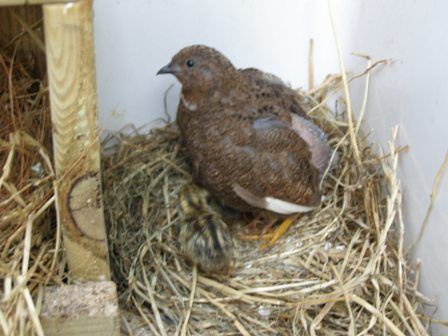
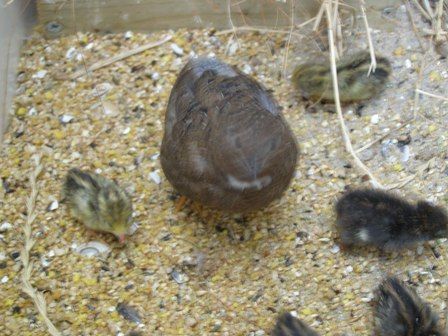
20-06-2008
Today I added a few photos of the newly fledged Cuban finches and the young masked finch.
08-06-2008
A few weeks have passed and the first results are there, a bit on the mediocre side, but for some reason I have that often.
Just a small summary: 4 fledged beautiful large diamond finches, masked finches, Ceres finches, of course zebra finches and Japanese seagulls.
Ringed the following birds this week: belted finches, Cuban finches and a pair of red-headed parrot finches.
I've also been experimenting a bit with the digital camera, so I've added some photos here and here.
10-5-2008
Fortunately, one mask survived and I ringed it today. The 2 ceresses and the 4 young diamond finches have to wait a few more days before they can be ringed.
The 2 pairs of red heads were taken out of the breeding cages and placed in the aviary with another pair. The 2 couples had 1 round of unfertilized breeding, but after 3 weeks they showed no sign of continuing, hence my choice to move them to the aviary.
03-05-2008
Today two young masks, unfortunately one was crushed to death by the parents being stuck.
Furthermore, yesterday I bought a beautiful pair of colorful red-headed parrot finches, especially the male is very beautiful, a beautiful robust bird with a lot of very yellow, the female is slightly smaller in size and color.
First let me get into the breeding cage and catch my breath before I start breeding with it.
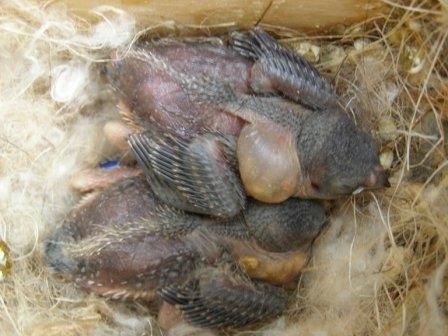
01-05-2008
Today I ringed my two zebra finches, numbers 51 and 52.
The weather is cooperating nicely, many couples already have eggs, but the majority are unfertilized, which is a pity, but better luck next time.
Well, two young ones from the pair of white-breasted zebra finches, my first of the year.

03-04-2008
A number of couples are working very energetically and are busy making nests and I have the first eggs from several couples. The couples in the breeding cages, including two couples of belted parrots and 1 couple of red-headed parrot finch, have also already laid their first eggs. I also expect some eggs from a number of other couples in the coming week, the nests are practically ready.
There is also a lot of activity in the three flights and things are already going well here.
29-3-2008
Yesterday we cleaned the three aviary flights and coupled the birds that do not go into the breeding cages. The Cuban finches have not yet been paired because both couples are still too young. They are from the end of August 2007, so I will give them some time, although I know that they can be used for breeding at a fairly young age, but I don't want to take any risks.
Today all flights were equipped with nest boxes and yes, a number of couples immediately started dragging nesting material. Also today I sawed into pieces the winding willow that I "rescued" from the neighborhood last week and decorated the flights with it. The mozambique siskins in particular love it and the man kept whistling vigorously.
25-3-2008
The first couples are already starting to drag nesting material, strangely enough the Cuban finches are not yet, while both the male and the female pay a lot of attention to each other. Patience is a virtue and I have never started pairing so early, let alone breeding.
24-3-2008
I couldn't resist and paired all the birds in the breeding cages, maybe a little early but I'll see what happens.
Also updated my breeding program in Zoo-easy.
March 23, 2008
Today, after putting the finishing touches to cleaning and tidying up yesterday, I filled my breeding cages with the first birds.
The following pupae have emerged: 2x wild-colored belted grass finches, 1x cream ini belted grass finches, 3x red-headed parrot finch, 3x small Cuban finch, 2x ceres finch and a female masked finch.
I already notice that some of the dolls are starting to get interested, I leave them alone for a week and then I'll bring in the first males next weekend.
These will probably be the red heads, belts, ceres and the masked finches and at least 1 pair of the three Cuban finches.
March 20, 2008
Today my new breeding cages arrived, this morning I took the cages apart before the rain and reassembled them in the lock.
The two blocks are on two tables, it took me quite some effort to adjust them, there is more than a cm of gradient in the floor, so it is good that the tables have pins.
Now that it is there it is a beautiful sight. At the weekend, soak it in soapy water, add ground cover and start caging the pupae.
I think I'll put 5 sets of red heads and 1 set of tricolor parrot finch in the largest block.
In the other block my three pairs of Cuban finches, 2 pairs of Ceres finch and the masks are allowed in.
March 16, 2008
Today, despite the bad weather, I want to empty the lock, because my new breeding cages will arrive on Thursday. Assembling with Van Keulen cages is a piece of cake, so if all goes well the first dolls might be caged on Thursday. I usually put the female in the breeding cage for a week so that it can get used to it before the males arrive.
I ordered two blocks, with the following dimensions d/h/w 40/50/120 or 100cm. I know it's on the tight side, but I have limited space in my lock and I still want to have the maximum number of breeding cages. By the way, the cages are on a nice base cabinet where I can store all my belongings.
The color, just like my aviary, is dark green.
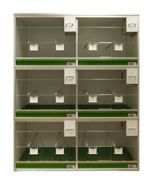
March 2, 2008
Today I sold my last breeding cages to a novice breeder. He was very happy with it.
I hope to use my new van Keulen cages in 2 weeks and then I can slowly but surely start pairing them. My redheads are already getting broody.
February 24, 2008
Cleaned my two breeding cages yesterday and put them on the marketplace today. Yes, you read that right, I can't resist buying new breeding cages. I have always been very satisfied with the Cologne cages again.
February 23, 2008
So, my new site is online. Not everything works yet, but the most important pages do. My wife is busy looking for a well-functioning guestbook, she will probably succeed.






